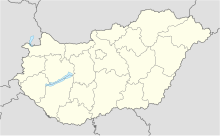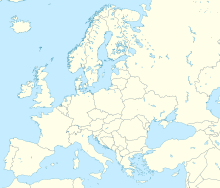Budapest Ferenc Liszt International Airport
This article needs additional citations for verification. (September 2016) |
Budapest Ferenc Liszt International Airport Budapest Liszt Ferenc Nemzetközi Repülőtér | |||||||||||||||
|---|---|---|---|---|---|---|---|---|---|---|---|---|---|---|---|
 | |||||||||||||||
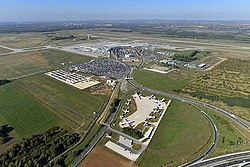 | |||||||||||||||
| Summary | |||||||||||||||
| Airport type | Public | ||||||||||||||
| Owner/Operator | Budapest Airport Ltd.[1] | ||||||||||||||
| Serves | Budapest metropolitan area | ||||||||||||||
| Location | 16 km (9.9 mi) south-east of center of Budapest | ||||||||||||||
| Hub for | |||||||||||||||
| Operating base for | Ryanair | ||||||||||||||
| Elevation AMSL | 151 m / 495 ft | ||||||||||||||
| Coordinates | 47°26′22″N 019°15′43″E / 47.43944°N 19.26194°E | ||||||||||||||
| Website | www | ||||||||||||||
| Map | |||||||||||||||
 | |||||||||||||||
| Runways | |||||||||||||||
| |||||||||||||||
| Statistics (2023) | |||||||||||||||
| |||||||||||||||
Budapest Ferenc Liszt International Airport[5] (Hungarian: Budapest Liszt Ferenc Nemzetközi Repülőtér, pronounced [ˈbudɒpɛʃt ˈlist ˈfɛrɛnt͡s ˈnɛmzɛtkøzi ˈrɛpyløːteːr]) (IATA: BUD, ICAO: LHBP), formerly known as Budapest Ferihegy International Airport and commonly denoted as Ferihegy (Hungarian pronunciation: [ˈfɛrihɛɟ]), is the international airport serving the Hungarian capital city of Budapest. It is the largest of the country's four commercial airports, ahead of Debrecen and Hévíz–Balaton. The airport is located 16 kilometres (8+1⁄2 nautical miles) southeast of the center of Budapest (bordering Pest county) and was renamed in 2011 after Hungarian composer Franz Liszt (Hungarian: Liszt Ferenc) on the occasion of his 200th birthday.[6] The facility covers 1,515 hectares (3,744 acres) and has two runways.[7]
It offers international connections primarily within Europe, but also to Africa, to the Middle East, and to the Far East. In 2019, the airport handled 16.2 million passengers. The airport is the headquarters and primary hub for Wizz Air and base for Ryanair.[8] In 2012 it experienced a significant drop in aircraft movements and handled cargo, primarily due to the collapse of Malév Hungarian Airlines earlier in the year, hence lost a large portion of connecting passengers. It had been the hub for Malév until the airline's bankruptcy on 3 February 2012.[9][10]
Name
[edit]Originally called Budapest Ferihegy International Airport (Budapest Ferihegy Nemzetközi Repülőtér), on 25 March 2011 it was officially renamed Budapest Liszt Ferenc International Airport in honour of the Hungarian pianist and composer Franz Liszt (Modern Hungarian: Liszt Ferenc). Popularly, the airport is still called Ferihegy as before.
Ferihegy is the name of the neighbourhood around the airport. The name is derived from that of Ferenc Xavér Mayerffy (1776–1845), the former owner of an estate who established vineyards and contributed to the development of viticulture in Pest-Buda. "Feri" is a diminutive form of Ferenc while "hegy" means mountain. In fact, the area is almost totally flat; but originally there was a 147 m high sandy hillock which was levelled in the 1940s during the construction of the airport.[6]
History
[edit]Designing and construction (1939–1944)
[edit]In 1938, the idea of building a new airport in Budapest was born. The area at the boundary of three settlements (Pestszentlőrinc, Rákoshegy and Vecsés) was assigned as the area of the new airport. The airport was intended as jointly for civil-military-sporting purposes. Civil facilities were to be built up in the northwestern section and military ones in the southwestern section. Just as for each building, a public tender was invited for the designing and construction of the traffic building.[6]
In December 1939, upon an announcement of the results of the tender invited in September that year, the designs of Károly Dávid Jr. (1903–1973) were chosen. The designer, who was one of the originators of modern Hungarian architectural art, dreamt of a building which resembled an aircraft from the top-side view. The work commenced in 1942. To approach the airport from the city, a 16-kilometre (10 mi) high-speed road was constructed between 1940 and 1943, which, after improvements, remains in use today.[6]
The military buildings were constructed parallel to the civil construction from 1940 but, due to the war situation, faster. Aviation started at the airport in 1943. In wartime, the civil construction slowed down and then stopped at the beginning of 1944. Towards the end of World War II, many of the airport buildings were damaged. By the end of 1944, Budapest and its airport were under Soviet occupation.[6]
Reconstruction (1947–1950)
[edit]In 1947, it was decided that the airport would be reconstructed for civil aviation. Under the three-year plan, 40 million forints were voted for those works. The opening ceremony was held in May 1950 and the sections finished allowed Magyar-Szovjet Polgári Légiforgalmi Rt. (Hungarian-Soviet Civil Aviation Co. Ltd. – MASZOVLET), established in 1946, to operate here. At that time the airlines operated only a few foreign flights, in particular, those to Prague, Bucharest, Warsaw, and Sofia.[6]
Magyar Légiforgalmi Vállalat (Hungarian Airlines – Malév) was established on 25 November 1954. The first regular flight taking off from the airport to the West was the Malév's flight into Vienna in summer 1956. The first Western airline which launched a flight to Budapest was KLM in 1957. The traffic building was finished in this period and the lengthening works of the 2,500-metre (8,202 ft) runway were started. At the end of 1958 the runway was lengthened to 3,010 metres (9,875 ft) and taxiway D was finished.[6]
Continued growth (1960–1980)
[edit]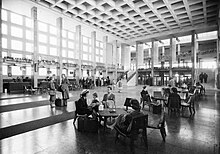

Between its opening and 1960, the number of landings at the Airport increased from 4,786 to 17,133, with passenger traffic increasing from 49,955 to 359,338 by 1960.[6]
In 1965, a study was made on the development of the airport, which was implemented with more than a 10-year delay from the end of the 1970s. Aviation, airport, and flight control all called for more capacity and infrastructure. The Aviation and Airport Directorate (LRI) was established on 1 January 1973 and performed as an airline company, a trading company, and an authority, as well as investment, operator, and air navigation tasks.
In 1974, passenger traffic reached one million. In 1977, a new control tower was built, as well as a second runway parallel to the old one and a technical base for maintaining MALÉV aircraft. Use of the new 3,707-metre (12,162 ft) runway was started in September 1983.[6]
New infrastructure (1980–2000)
[edit]
In 1980, the number of landing aircraft and passengers served reached 32,642 and 1,780,000, respectively. The growing number of passengers called for more capacity. A new terminal was decided upon. The foundation-stone of the new passenger traffic building to be built was laid down on 16 November 1983. [citation needed] Since 1 November 1985, passengers have been received in Terminal 2, a 24,000-square-meter facility funded with Austrian loans under general contracting. It was used first by Malév aircraft and passengers, and then by those of Lufthansa, Air France, and Swissair. The old terminal continued to receive residual airline traffic under a new name, Terminal 1. [citation needed]
There was an IED bus attack against Russian Jewish emigrants on the road leading to Ferihegy in the early 1990s. The perpetrators were members of the German Communist organisation Red Army Faction.[11]
In 1993, Malév launched the airport's first Hungarian overseas flight, to New York. According to the traffic figures forecast for the millennium, the two terminals serving 4 million passengers a year promised to be insufficient. [citation needed] The construction of Terminal 2B was started in 1997. The new building, with more than 30,000 square metres of space, together with a new apron, was opened in 1998, with all foreign airlines moving there. Terminal 2B can receive 3.5 million passengers a year, with its seven gates and five remote stands. [citation needed]
Public to public-private ownership (2000–2012)
[edit]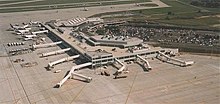
On 8 December 2005, a 75% stake in Ferihegy Airport was bought by BAA plc for 464.5 billion HUF (approx. US$2.1 billion), including the right of operation for 75 years. [citation needed] On 20 October 2006, BAA announced intentions to sell its stake in Budapest Airport to a consortium led by the German airport group, HOCHTIEF AirPort GmbH, subject to the consent of the Hungarian State. [citation needed]
On 18 April 2007, the renovation of Terminal 1 at Ferihegy was awarded Europe's most prestigious heritage preservation prize, the Europa Nostra award.[citation needed] The designers, contractors, builders and investors (the latter being BA) received the joint award of the European Commission and of the pan-European heritage preservation organisation Europa Nostra for the renovation of the protected monument spaces, the central hall, the gallery and the furniture at T1.
On 6 June 2007, BAA and a consortium led by HOCHTIEF AirPort (HTA) formally closed and completed the transaction of the sale of BAA's shares in Budapest Airport (BA) to the HOCHTIEF AirPort Consortium. The ownership of the HOCHTIEF AirPort Consortium was as follows: HOCHTIEF AirPort (49.666%) and three financial investors: Caisse de dépôt et placement du Québec, Montreal (23.167%), GIC Special Investments, Singapore (23.167%) and KfW IPEX-Bank, Frankfurt (4.0%).[12]
On 26 July 2010, after completing a security oversight investigation in May,[13] the EU authorities revoked Budapest Airport's official "Schengen Clear" certification, due to serious lapses observed in personal security check procedures and unauthorised passing of banned objects. This meant passengers connecting via another airport in the Schengen Zone would have to be rescreened through security, just as foreign non-Schengen connecting passengers, causing delays and inconvenience. The airport argued that it had not yet had time to fully implement new security measures introduced on 29 April 2010, and inspired by the Delta Air Lines' Amsterdam "underwear bomb scare" incident. The airport's layout was also cited as an excuse for the failure. Budapest Airport was the first airport to be checked through a stringent undercover evaluation for compliance with the new regulation. (Hungarian state news agency MTI reports: [2] [permanent dead link]) In response, additional security measures were immediately implemented at Budapest Airport causing flight delays at both terminals. Unusually long passenger waiting queues were observed at the busier 2A-B terminal complex's departures area. These problems were solved over time, especially through the opening of the SkyCourt terminal including a central security zone. [citation needed]
On 15 November 2010, Budapest Airport regained the "Schengen Clear"-status, after implementing the necessary security actions and after that, the airport underwent the strict re-inspection.[14]
On 16 March 2011, the name of Budapest Ferihegy International Airport was changed to Budapest Ferenc Liszt International Airport.[2]
Sky Court, the new expansion project including shops, restaurants and lounges, also connecting Terminals 2A and 2B was opened on 27 March 2011. In summer that year, the refurbishing of the old terminal parts in T2 began and was completed in 2012.[15]
Collapse of Malév, aftermath, and future (2012–present)
[edit]In the wake of the collapse of Malév, Ryanair announced that it would expand its flights to Liszt airport. Ryanair began selling the flight tickets to the public, but Budapest airport said that the company had not secured all of the necessary slots (which were later negotiated successfully).[16] By 9 February 2012, only six days after the collapse of the Hungarian national carrier, Liszt Ferenc Airport had recovered over 60% of its point to point traffic. Airlines that announced that new services would begin included Wizz Air, Aegean Airlines, Air Berlin, Lufthansa, and Ryanair.
However, the airport had lost Malév's transfer passengers, which, prior to the airline's collapse, had amounted to 1.5 million passengers per year. A second effect of the Malév collapse was that the areas used to service the Malév fleet would no longer generate revenue even once point to point traffic had been restored. These factors created significant financial shortfalls in the airport's revenues.[17]
In February 2012, Hainan Airlines announced that they would cease services to Beijing from Budapest.[18] Prior to the collapse of Malév, Hainan had a partnership with Malév,[19] which included a codeshare.[20]
In May 2013, Hochtief Group announced the sale of its Airports unit HOCHTIEF AirPort which held a stake in the Budapest Airport and other airports to the Canadian Pension fund Public Sector Pension Investment Board (PSP Investments).[21] Following the sale HOCHTIEF AirPort was renamed AviAlliance.[22]
In July 2015, the ownership of Budapest Airport was the following:
- AviAlliance (52.666%) owned by PSP Investments, Canada,
- Malton Investment (22.167%) owned by GIC Special Investments, Singapore,
- Caisse de dépôt et placement du Québec, Canada (20.167%),
- KfW IPEX-Bank, Germany (5%).[23]
261 million euros was spent on expanding and modernising the airport infrastructure until December 2012. Several of these future projects[clarification needed] involve about further 300 million euros, and depend on regulatory decisions as well as third-party investors.[24] Since 2011, several projects have been completed, including the refurbishment of Terminals 2A and 2B with the inauguration of the Skycourt main departures hall in 2012 and an extension of Terminal 2B in 2018,[25] the construction of a new business and cargo area called Budapest Airport Business Park[26][27] as well as a new airport hotel[28] and expanded car parking facilities.
In 2014, Emirates opened daily flights to Dubai, UAE using the Boeing 777-300ER aircraft. It was followed by Air China's flights to Beijing Capital. In 2019, Shanghai Airlines launched a four-times weekly service to Shanghai–Pudong, also with the Boeing 787 Dreamliner.
In 2015, North American and Middle Eastern carriers announced direct flights to Budapest.[citation needed] In 2018, LOT Polish Airlines made Budapest their first hub outside Poland, launching with year-round flights to New York-JFK and Chicago-ORD. In 2018, American Airlines resumed flights to Budapest. American Airlines this time flew from Philadelphia, after flights from New York-JFK were suspended in 2011. PHL-BUD[clarification needed] operated for the two summers of 2018 and 2019, May–October, and was planned to continue the following summers as well. Chicago-ORD flights were planned to start in 2020, but were axed in April 2020, just a month before the inaugural flight. LOT Polish Airlines axed their Chicago-ORD flight in August 2019, just days after American Airlines announced plans to operate the same route starting May 2020.[citation needed] Nowadays, the Budapest hub of Wizz Air is the largest of all, with more than 60 destinations.[citation needed]
There are further projects for the expansion of the airport, including a new cargo facilities area as well as a new Terminal 3,[29] formerly called Terminal 2C and originally planned by 2020. In a 2021 interview, however, the newly appointed CEO stated that the construction of the new passenger hall could commence in 2025.[30]
In 2020, according to a report from Bloomberg, the Hungarian government was looking at buying the airport from its foreign owners such as GIC (Singaporean sovereign wealth fund) and Canadian AviAlliance. Prime Minister Viktor Orbán was opposed to the 2005 privatization.[31] In September 2023 the government made a formal bid to buy Budapest Airport.[32]
On June 6, 2024, the government of Hungary announced that, together with Vinci Airports, they have purchased Budapest Airport, the operator of Budapest Liszt Ferenc International Airport, from its previous owners.[33] Hungary and Vinci, after paying €3.1 billion in cash and assuming a net debt of €1.2 billion, now hold 80% and 20% ownership of the capital's airport, respectively. [34] Vinci Airports will be the platform operator for decades to come, with a concession expiring in 2080.[35] Mate Loga, State Secretary for Economic Strategy was appointed to be the Chairman of Budapest Airport, while Francois Bérisot serves as CEO now.
Terminals
[edit]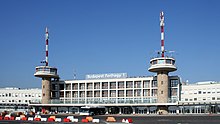

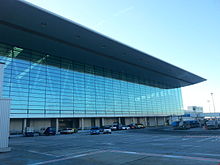

The airport's passenger buildings consist of four main areas:
- Terminal 1 is only used for charter and private flights
- Terminal 2A is used for flights inside the Schengen Area
- Terminal 2B is used for flights outside the Schengen Area
- Sky Court, a large central waiting and shopping area, also the connection of Terminals 2A and 2B
Terminal 1 (closed)
[edit]From 1 September 2005, re-opened Terminal 1 served low-cost carriers. Terminal 1 is divided into Schengen and Non-Schengen boarding gates.[36]
Being located within the premises of Budapest, it offers faster public transport time to the city centre, compared to the Terminal 2 about 3 kilometres farther. (Terminal 1 offers an about 20 minutes direct train journey to Budapest city centre, while Terminal 2 requires an 8-minute bus ride to the train station).[37]
On 14 March 2012, Budapest Airport announced that due to the traffic levels being too low in Terminal 1, extra capacity in Terminal 2, and cost saving, Terminal 1 will be closed temporarily. On 30 May 2012 all airlines were moved to Terminal 2, the low-cost airlines using now the check-in desks at hall 2B and gates at a makeshift shed outside the main building. This shed now does not operate, a new pier was opened instead.
Sky Court between Terminal 2A and 2B
[edit]Sky Court is a state-of-the-art building between terminals 2A and 2B with 5 levels. Passenger safety checks were moved here along with new baggage classifiers and business class lounges, such as the first MasterCard lounge in Europe.[38] New shops, restaurants and cafés were placed in the new building's transit hall. With the opening of Skycourt the Terminal 2 has become capable of receiving about 11 million passengers a year, instead of the former joint capacity of about 7 million. [citation needed]
Terminal 2A
[edit]The Schengen terminal, and formerly the "only" Terminal 2. It was inaugurated on 1 November 1985 for the exclusive use of the homeland carrier Malév Hungarian Airlines, and later renamed in 1998 to Terminal 2A. Its check-in hall serves all Skyteam and Star Alliance member airlines currently. Within its boarding area (Gates A1-A33) and arrivals level, it serves all flights to and from the Schengen-zone destinations of any airline.
Terminal 2B
[edit]The non-Schengen terminal, it is referred to as a separate object, opened in December 1998. Its check-in hall serves all flights of the OneWorld-alliance (intra- and extra-Schengen as well), as well as many other non-aligned airlines. For flights of the Hungarian low-cost airliner Wizz Air check-in desks can also be found at this terminal. However, its boarding (Gates B1-B44) and arriving area serve exclusively non-Schengen destinations.
Pier 2B
[edit]The project "Pier B" was started on 9 January 2017. The new state-of-the-art building opened on 1 August 2018, and it is connected directly to Terminal 2B. It is 220 meters long and it includes 27 boarding gates and 10 jetbridges, which can serve more wide-body aircraft at the same time. The pier was planned to offer flexibility for traditional and low-cost airlines with boarding options via jetbridges, buses or walking directly to the aircraft.
Airlines and destinations
[edit]Passenger
[edit]As of September 2024, the following airlines operate regular scheduled and charter services to and from Budapest Ferenc Liszt Airport:[39]
Cargo
[edit]Statistics
[edit]Traffic figures
[edit]| Passengers | Change from previous year | Aircraft operations | Change from previous year | Cargo (metric tons) |
Change from previous year | |
|---|---|---|---|---|---|---|
| 2010 | 8,179,406 | 105 507 | 65,515 | |||
| 2011 | 8,911,273 | 109,949 | 106,595 | |||
| 2012 | 8,493,569 | 87,560 | 93,125 | |||
| 2013 | 8,510,896 | 83,830 | 92,112 | |||
| 2014 | 9,146,723 | 86,682 | 89,987 | |||
| 2015 | 10,289,180 | 92,294 | 91,421 | |||
| 2016 | 11,441,999 | 96,141 | 112,142 | |||
| 2017 | 13,097,239 | 102,747 | 127,145 | |||
| 2018 | 14,867,491 | 115,028 | 146,113 | |||
| 2019 | 16,173,489 | 122,814 | 135,521 | |||
| 2020 | 3,665,317 | n.a. | 134,459 | |||
| 2021 | 4,622,882 | n.a. | 183,362 | |||
| 2022 | 12,205,070 | n.a. | 194,000 | |||
| 2023 | 14,701,080 | n.a. | 201,306 |
Top destinations
[edit]| Rank | Airport | Passengers handled | % change 2018/19 |
|---|---|---|---|
| 1 | 725,600 | ||
| 2 | 568,081 | ||
| 3 | 509,371 | ||
| 4 | 487,029 | ||
| 5 | 454,181 | ||
| 6 | 440,792 | ||
| 7 | 380,331 | ||
| 8 | 371,288 | ||
| 9 | 339,734 | ||
| 10 | 338,095 | ||
| 11 | 313,642 | ||
| 12 | 305,005 | ||
| 13 | 299,208 | ||
| 14 | 295,990 | ||
| 15 | 286,987 | ||
| 16 | 284,145 | ||
| 17 | 263,815 | ||
| 18 | 257,550 | ||
| 19 | 250,544 | ||
| 20 | 243,221 | ||
| 21 | 235,851 | ||
| 22 | 233,067 | ||
| 23 | 231,472 | ||
| 24 | 229,137 | ||
| 25 | 214,130 | ||
| 26 | 211,433 | ||
| 27 | 208,527 | ||
| 28 | 207,802 | ||
| 29 | 207,068 | ||
| 30 | 201,870 |
| Rank | Airport | Passengers handled |
% change 2017/18 |
Rank | Airport | Passengers handled |
% change 2017/18 | |
|---|---|---|---|---|---|---|---|---|
| Europe | 16 | 246,616 | ||||||
| 1 | 661,820 | 17 | 241,153 | |||||
| 2 | 564,603 | 18 | 240,803 | |||||
| 3 | 462,651 | 19 | 240,499 | |||||
| 4 | 452,509 | 20 | 238,254 | |||||
| 5 | 427,507 | 21 | 234,034 | |||||
| 6 | 363,483 | 22 | 205,501 | |||||
| 7 | 361,246 | 23 | 200,864 | |||||
| 8 | 345,210 | 24 | 180,060 | |||||
| 9 | 344,042 | 25 | 175,781 | |||||
| 10 | 337,577 | 26 | 174,312 | |||||
| 11 | 281,704 | 27 | 167,626 | |||||
| 12 | 277,848 | Outside Europe | ||||||
| 13 | 273,830 | 1 | 430,502 | |||||
| 14 | 268,155 | 2 | 220,589 | |||||
| 15 | 262,000 | 3 | 167,532 | |||||
| Rank | Airport | Passengers handled |
% change 2016/17 |
|---|---|---|---|
| 1 | 574,074 | ||
| 2 | 471,911 | ||
| 3 | 449,214 | ||
| 4 | 443,957 | ||
| 5 | 390,608 | ||
| 6 | 363,235 | ||
| 7 | 350,152 | ||
| 8 | 343,275 | ||
| 9 | 333,780 | ||
| 10 | 262,914 | ||
| 11 | 262,497 | ||
| 12 | 246,337 | ||
| 13 | 243,231 | ||
| 14 | 238,238 | ||
| 15 | 237,772 | ||
| 16 | 237,313 | ||
| 17 | 235,418 | ||
| 18 | 230,734 | ||
| 19 | 227,907 | ||
| 20 | 224,605 | ||
| 21 | 223,112 | ||
| 22 | 221,132 | ||
| 23 | 213,920 | ||
| 24 | 203,636 | ||
| 25 | 197,455 | ||
| 26 | 181,310 | ||
| 27 | 166,229 | ||
| 28 | 152,710 | ||
| 29 | 141,525 | ||
| 30 | 136,259 |
Other facilities
[edit]- Wizz Air has its head office in Building 221.[116] Wizz Air signed the lease agreement in October 2010 and moved there in June 2011 with 150 employees. The airline occupies over 2,000 square metres (22,000 sq ft) of space in an office building refurbished after the airline's arrival. The facility, with open plan offices, houses about 150 employees.[117] In addition, Farnair Hungary has its head office on the airport property.[118]
- Malév Hungarian Airlines signed a lease agreement with the airport in the spring of 2011, agreeing to relocate its headquarters to the airport grounds by the summer of 2012.[117][119] Due to the collapse of the airline, in February 2012 the plans to move to Ferenc Liszt were cancelled.
Ground transportation
[edit]Public transport
[edit]Local buses
[edit]
Budapesti Közlekedési Központ (BKK), the public transit authority for Budapest, operates two major express bus services to the airport: 100E and 200E. Route 100E—modeled after the OrlyBus and RoissyBus airport bus services in Paris—provides nonstop service to the city center, stopping only at Kálvin tér and Deák Ferenc tér. Standard tickets and passes cannot be used on this route; a higher-fare ticket must be bought on board or at the airport's BKK ticket machines.
Bus route 200E provides service from the airport to Kőbánya-Kispest station, the nearest station of the Budapest Metro. Standard tickets and passes are valid on this route.
Long-distance buses
[edit]Flixbus operates long-distance routes from the airport to numerous Central European cities, including Prague, Vienna, Timișoara, and Sibiu.
Rail
[edit]Hungarian State Railways (MÁV) services stop at the nearby Ferihegy railway station, which can be accessed from Terminal 2 by bus route 200E. Trips into the city center from Ferihegy station take approximately 25 minutes, but service is infrequent. Ferihegy station formerly served the airport's Terminal 1, which no longer hosts passenger air services.
Taxi
[edit]Budapest Airport's official Taxi partner is Főtaxi which has a taxi order stand at both arrival site's exit (outside the building).[120]
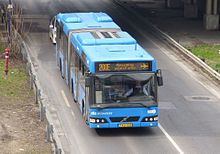
Mini buses and shuttles
[edit]Several companies operate airport shuttles taking passengers to any destination in the city. Other shuttles and coach services exist to outlying towns in Hungary, Romania, Slovakia, and Serbia.
Accidents and Incidents
[edit]- On August 6, 1961, a Malev Hungarian Airlines Douglas C-47A crashed into a residential area during a sightseeing flight. All 4 crew and 23 passengers were killed along with 3 on the ground.[121]
- On January 15, 1975, Malev Hungarian Airlines Flight 801, an Ilyushin IL-18, a ferry/positioning flight, crashed 1360m beyond runway 31 and 120m left of the centerline because of bad weather, darkness, fog, lack of crew coordination and possible spatial orientation. All 9 occupants died.[122]
- On February 22, 1994, a Malev Hungarian Airlines Tupolev TU-134 caught fire on the ground during a maintenance check at Budapest Airport. Four maintenance technicians died.[123]
See also
[edit]- Debrecen International Airport
- List of airports in Hungary
- Transport in Hungary
- Aeropark aviation museum
References
[edit]- ^ "Owners of Budapest Airport Zrt.(Ltd.)". bud (Budapest Airport). 8 December 2014. Archived from the original on 6 January 2015.
- ^ "Kiderült, melyik városokba utaztak a legtöbben tavaly a ferihegyi reptérről". 20 January 2024.
- ^ "ACI EUROPE Airport Traffic Report. December, Q4 and Full Year 2015" (PDF). Retrieved 28 August 2016.
- ^ "Hungary AIP (final, November 12, 2015)". Retrieved 28 August 2016.
- ^ "Cargo City construction at Budapest Airport". bud (Budapest Airport). Archived from the original on 6 March 2012. Retrieved 4 February 2012.
- ^ a b c d e f g h i "History". bud (Budapest Airport). Retrieved 17 July 2019.
- ^ "Budapest Airport Facts". www.bud.hu. Retrieved 10 October 2023.
- ^ "PORTFOLIO.HU – Online Financial Journal". Retrieved 3 June 2015.
- ^ "Press release of Malév Zrt". bud (Budapest Airport). Archived from the original on 26 June 2015. Retrieved 3 June 2015.
- ^ Dunai, Marton and Gergely Szakacs. "Rivals swoop in as Hungary's Malev stops flying Archived 24 September 2015 at the Wayback Machine." Reuters. Friday 3 February 2012.
- ^ Kirsten Grieshaber (29 September 2004). "World Briefing – Europe: Germany: Sentencing In 1991 Attack On Jews". The New York Times. Retrieved 3 January 2009.
- ^ "HOCHTIEF AirPort Consortium takes over Budapest Airport". bud (Budapest Airport). Archived from the original on 25 July 2015.
- ^ "Budapest airport security status downgraded: Civil aviation". Retrieved 3 June 2015.
- ^ "Budapest Business Journal". Archived from the original on 18 December 2013. Retrieved 3 June 2015.
- ^ "New shops opening one after the other". bud (Budapest Airport). Archived from the original on 13 June 2015. Retrieved 3 June 2015.
- ^ Eddy, Kester. "Ryanair vs Budapest: playing dirty? Archived 24 May 2017 at the Wayback Machine" Financial Times. 7 February 2012. Retrieved on 9 February 2012.
- ^ Simon, Zoltan. "Hungary Seeks Budapest Airport Compromise to Protect Budget." BusinessWeek. 9 February 2012. Retrieved on 9 February 2012.
- ^ *"Hainan Airlines arrête son Pékin – Budapest." Air Journal. 14 February 2012. Retrieved on 30 August 2012.
- ^ "Felfüggesztik a Peking-Budapest közvetlen légi járatot." China Radio International. 24 February 2012. Retrieved on 31 August 2012.
- ^ "Partner airlines." Malév. 3 January 2011. Retrieved on 31 August 2012.
- ^ "Budapest Airport stake sold to Canadian pension fund manager". Budapest Business Journal.
- ^ "History – AviAlliance". AviAlliance corporate website.
- ^ "Ownership of the Budapest Airport". bud (Budapest Airport). Archived from the original on 23 October 2013.
- ^ "Részletes repülőjárat információk, parkolási lehetőségek – bud.hu: Property". bud (Budapest Airport). Archived from the original on 24 December 2011. Retrieved 29 April 2017.
- ^ "New passenger pier inaugurated at Budapest Airport with Astana flight". bud (Budapest Airport). 1 August 2018. Retrieved 7 August 2018.
- ^ "DHL moves to Budapest Airport Business Park". bud (Budapest Airport). 7 August 2013. Archived from the original on 4 March 2016. Retrieved 3 June 2015.
- ^ "DHL moves to Budapest Airport Business Park". bud (Budapest Airport). 15 December 2012. Archived from the original on 23 September 2015. Retrieved 3 June 2015.
- ^ "Business Traveller – Szállás – Vendégeket vár az ibis Styles Budapest Airport". Business Traveller Hungary. Archived from the original on 10 January 2018. Retrieved 9 January 2018.
- ^ "2017-re Airport Hotelt, 2020-ra C Terminált épít a Budapest Airport" [By 2017 Airport Hotel by 2020 C Terminal is built by Budapest Airport] (in Hungarian). 8 December 2015.
- ^ "Terminal 1 could reopen, the construction of Terminal 3 could begin in 2025 at Ferihegy". 13 May 2021.
- ^ "Orban Allies Seek to Grab Control Over Budapest Airport – Bloomberg". Bloomberg News. Archived from the original on 11 October 2020.
- ^ "Hungary's government submits new formal bid for Budapest Airport, shareholder says". Reuters. 6 September 2023. Retrieved 13 November 2023.
- ^ "Visszavásárolta a kormány a ferihegyi repülőteret". Portfolio.hu. 6 June 2024.
- ^ "Hungary and Vinci Buy Budapest Airport in $4.7 Billion Deal". 6 June 2024 – via www.bloomberg.com.
- ^ "VINCI acquires a 20% shareholding in the Budapest airport concession company and becomes the platform operator - MarketScreener". www.marketscreener.com. 6 June 2024.
- ^ "Budapest Airport is prepared for Schengen accession – as of 30 March, Terminal 2A handles Schengen and Terminal 2B non-Schengen traffic". bud (Budapest Airport). Archived from the original on 4 March 2016. Retrieved 3 June 2015.
- ^ "By train". bud (Budapest Airport). Archived from the original on 12 May 2015. Retrieved 3 June 2015.
- ^ "Emerald Media – First MasterCard Lounge in Europe inaugurated at Budapest Airport". Retrieved 29 April 2017.
- ^ "Timetable and route planner". bud (Budapest Airport). Archived from the original on 9 January 2017. Retrieved 8 January 2017.
- ^ "Aer Lingus".
- ^ "AeroexpressRegional Begins Operation in 5 Sept 2022".
- ^ "AIR CAIRO 4Q22 NETWORK ADDITIONS SUMMARY – 13OCT22". aeroroutes.com. 13 October 2022.
- ^ "Air China Resumes Beijing-Budapest Flight". 27 June 2022.
- ^ "Air China NW22 International Operations – 30OCT22". Aeroroutes. Retrieved 31 October 2022.
- ^ "Air France NS24 Paris European Frequency Variations – 21JAN24". Aeroroutes.
- ^ "Air Serbia reveals third set of new routes". 8 December 2022.
- ^ "Járatokat indít Budapestre a Turkish Airlines diszkont légitársasága". April 2022.
- ^ קוטלר, עמית (22 October 2024). "החל מ-169 דולר: מילאנו, בודפשט, דובאי וגם יוון וקפריסין. לוח הטיסות החדש של ארקיע". פספורטניוז (in Hebrew). PassportNews. Retrieved 22 October 2024.
- ^ "Austrian NW24 Europe Frequency Changes – 26MAY24". Aeroroutes.
- ^ קוטלר, עמית (22 October 2024). "החל מ-59$ לכיוון, 198$ לטיסת הלוך ושוב: מבצעי החזרה לישראל של Blue Bird". פספורטניוז (in Hebrew). PassportNews. Retrieved 22 October 2024.
- ^ "British Airways NW24 Heathrow – Europe Frequency Changes – 27OCT24". Aeroroutes. Aeroroutes. Retrieved 31 October 2024.
- ^ "Brussels Airlines NW24 Europe Frequency Changes – 26MAY24". Aeroroutes.
- ^ "Budapest Airport expands reach with China Southern Airlines partnership and Guangzhou route". Aviation24.be. 11 April 2024. Retrieved 12 April 2024.
- ^ "Párizs és Budapest között indít járatot ősszel az Easyjet". 27 June 2024.
- ^ "Israel's El Al to drop UP budget brand". ch-aviation.com. Retrieved 7 January 2018.
- ^ "American / Finnair Expands Europe Codeshare Service From July 2023". Aeroroutes.
- ^ "Hainan Airlines will join the fray from August with a nonstop service between Shenzhen and Budapest". businesstraveller.com. Retrieved 9 July 2024.
- ^ "IBERIA NW24 Madrid – Europe Frequency Changes – 26MAY24". Aeroroutes.
- ^ "Israir NS24 Leased Smartwings Boeing 737 Operations". AeroRoutes. 21 March 2024. Retrieved 22 March 2024.
- ^ a b "Flight Timetable". jet2.com.
- ^ "Jet2.com Schedules Boeing 757 Service until early-Jan 2025". Aeroroutes.
- ^ "Korean Air Begins Budapest Service from Oct 2022".
- ^ "Qanot Sharq Moves Budapest / Milan Addition to Late-June 2024". AeroRoutes. 26 April 2024. Retrieved 9 May 2024.
- ^ "Ryanair". www.ryanair.com.
- ^ https://www.aeroroutes.com/eng/230918-frnw23
- ^ "Ryanair NS23 Network Additions Summary – 26MAR23". Aeroroutes.
- ^ https://www.aeroroutes.com/eng/231030-uknw23
- ^ "Ryanair Moves Additional Routes to Ryanair UK in NS23". Aeroroutes.
- ^ "Ryanair wznawia hitową trasę z Polski! Znów polecimy do bajecznej Portugalii".
- ^ "Júniustól újra repül Hahn és Budapest között a Ryanair". 13 January 2024.
- ^ "LJLA to introduce new SunExpress summer route to Türkiye | TheBusinessDesk.com". 9 May 2024.
- ^ "Ryanair apre tre nuove rotte da Milano Malpensa, compreso il volo giornaliero per Budapest". 5 December 2023.
- ^ Lifshitz-Klieger, Iris (4 April 2024). "Irish low-cost carrier Ryanair to resume Israel operations". Ynetnews. Retrieved 6 April 2024.
- ^ https://www.aeroroutes.com/eng/230918-frnw23
- ^ "Ryanair NS24 Network Additions – 10DEC23". AeroRoutes.
- ^ "News for Airlines, Airports and the Aviation Industry | CAPA". centreforaviation.com.
- ^ "Ryanair Expands Summer Routes from Trieste with Two New Destinations: Budapest and Olbia". 31 January 2024.
- ^ "Ryanair NW22 Network Additions Summary – 09DEC22". Aeroroutes.
- ^ "Szkiathosz szigetére indít járatot Budapestről a Ryanair". 5 December 2023.
- ^ "SAS NS25 COPENHAGEN NETWORK EXPANSION". AeroRoutes. 18 September 2024.
- ^ "Ningbo-Budapest Flight Route is of Great Importance in Light of the War". 20 June 2023.
- ^ "China Eastern NW22 International Operations – 30OCT22". AeroRoutes. 31 October 2022. Retrieved 31 October 2022.
- ^ "Budapest Airport welcomes return of Xi'An connection with Shanghai Airlines". Aviation24. 23 April 2024. Retrieved 24 April 2024.
- ^ "Smartwings Hungary NS23 Charter Network Additions".
- ^ "Travel Service Polska adds Budapest routes in S17". Retrieved 29 April 2017.
- ^ "Travel Service: Három új útvonal és 13%-os kapacitásbővítés a nyári menetrendben". 27 February 2018.
- ^ "SunExpress files additional new routes in S19". routesonline.com. 21 February 2019.
- ^ Liu, Jim. "SunExpress S20 network additions as of 22OCT19". Routesonline. Retrieved 23 October 2019.
- ^ "SWISS NW24 Europe Frequency Changes – 27OCT24". Aeroroutes. Aeroroutes. Retrieved 30 October 2024.
- ^ "TAROM NS23 Service Adjustment – 11JAN23". Aeroroutes.com. Retrieved 2 November 2024.
- ^ a b "Tui River Cruises unveils summer 2024 programme".
- ^ "WIZZ – Dream more. Live more. Be more".
- ^ a b c d e f "BREAKING: Hungarian Wizz Air launches six new flights from Budapest! - UPDATED - Daily News Hungary". 28 February 2024.
- ^ a b "Új útvonalakat jelentett be a Wizz Air, már ide is elrepítenek októbertől | Startlap Utazás". 21 March 2023.
- ^ a b c d e "Wizz Air NW24 Network Additions – 14SEP24". Aeroroutes. Retrieved 18 September 2024.
- ^ "Kairóba indít járatokat Budapestről a Wizz Air". 15 June 2023.
- ^ "Airline giant quits Scottish airport to launch flights from rival city". 5 October 2023.
- ^ "Wizz Air establishes operations at Stockholm Arlanda with two new direct routes". 26 September 2023.
- ^ "Wizz Air Flights to Operate Again between Budapest and Tel Aviv". Hungary Today. 17 January 2024. Retrieved 17 January 2024.
- ^ "Wizz Air ÚJ JÁRATOK Magyarországról Isztambulba és Antalyába". 19 January 2023.
- ^ "Wizz Air to Launch New Flight from Budapest to the Exotic Gran Canaria". 5 July 2024.
- ^ cargolux.com – Network & Offices retrieved 24 July 2020
- ^ "Cargolux Schedule Worldwide May 2023" (PDF). Cargolux. Retrieved 11 May 2023.
- ^ "China Cargo Airlines launches Shanghai-Budapest". Stat Times. 18 July 2024. Retrieved 21 July 2024.
- ^ airlineroutemaps.com – FedEx retrieved 14 August 2022
- ^ aircargonews.net retrieved 22 December 2022
- ^ "Korean Air launches direct ICN-BUD cargo flight". AIRCARGOWORLD.COM. 21 February 2020. Retrieved 7 March 2020.
- ^ – My Freighter retrieved 1 february 2024
- ^ "My Freighter routes and destinations". Flightradar24. Retrieved 28 June 2024.
- ^ qrcargo.com retrieved 12 September 2019
- ^ "SF Airlines launches China-Hungary route". Stat Times. 18 June 2024. Retrieved 27 June 2024.
- ^ [1] retrieved 24 July 2020
- ^ turkishcargo.com – Flight Schedule retrieved 24 July 2020
- ^ airlineroutemaps.com – UPS retrieved 24 July 2020
- ^ "Company overview." Archived 12 March 2009 at the Wayback Machine. Wizz Air. Retrieved on 11 December 2011. "Wizz Air Hungary Airlines Ltd. BUD International Airport Building 221 H-1185 Budapest"
- ^ a b "Property development". bud (Budapest Airport). Archived from the original on 24 December 2011. Retrieved 11 December 2011.
- ^ "Our Offices." Archived 5 February 2012 at the Wayback Machine. Farnair Europe. Retrieved on 19 February 2012. "H-1185 Budapest Liszt Ferenc ROK 17. Hungary"
- ^ "MALÉV HEADQUARTERS MOVES BACK TO BUDAPEST AIRPORT." Malév Hungarian Airlines. 20 April 2011. Retrieved on 4 February 2012.
- ^ "BUD's website about their official taxi partner". bud (Budapest Airport). Retrieved 17 March 2018.
- ^ Accident description for HA-TSA at the Aviation Safety Network. Retrieved on October 10, 2023.
- ^ Accident description for HA-MOH at the Aviation Safety Network. Retrieved on October 10, 2023.
- ^ Accident description for HA-LBD at the Aviation Safety Network
External links
[edit]![]() Media related to Budapest Liszt Ferenc International Airport at Wikimedia Commons
Media related to Budapest Liszt Ferenc International Airport at Wikimedia Commons

